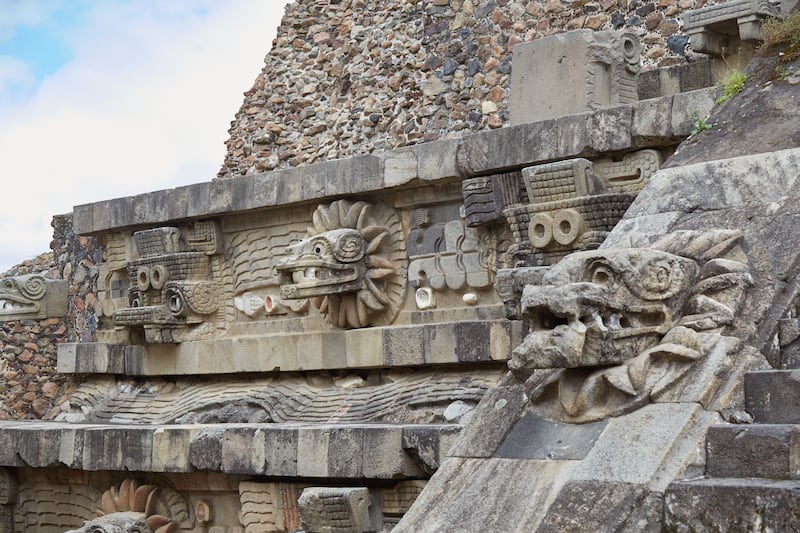Perhaps the most important god in the mythology of ancient Mesoamerica — and surely one of the most complex and difficult to understand — is Quetzalcoatl.
When trying to appreciate the role of this god in Pre-Columbian Mesoamerica, it is vital, first, to distinguish between the mythic god himself and the legendary Toltec priest and king Topiltzin Quetzalcoatl with whom he is easily confused. Second, it is essential to pay very careful attention to the dates and locations of the various elements of the mythology.
The Aztec name “Quetzalcoatl” means “quetzal-feathered serpent,” referring to the beautiful blue and green plumage of the quetzal bird. In Maya dialects he is known as Kukulcan. Archaeological evidence exists for the worship of Quetzalcoatl from at least the first century in Teotihuacan, the massive urban center and temple-complex whose famous pyramids are located near modern Mexico City. Iconographic elements of his cult can be traced back even further. But the veneration of Quetzalcoatl rises to its greatest significance after A.D. 900 among the Toltecs of Tollan (Tula), the post-Classical Maya of the Yucatan, and the Aztecs.
We must keep in mind, however, that the most important surviving written sources for the legends of Quetzalcoatl derive from 16th-century (i.e., post-conquest) Spanish translations and descriptions of Aztec history, religion, literature and legends. It is uncertain how far back in time many elements of the Quetzalcoatl legends can be traced, and it is difficult to know how accurately the Spanish understood and recorded them.
Mythologically, Quetzalcoatl plays an important role in both the creation of the universe and the invention of culture, including the discovery of agriculture, science, the arts and fire. He is frequently worshiped as the patron god of science and learning.
In mythic times, he participated in a primordial sacrifice, in which he descended into the underworld, outwitted the god of the dead (Mictlantecuhtli), and rescued mankind from the power of death. Thereafter, he ascended into heaven, where he became the evening-and-morning star Venus (in Aztec, Tlahuizcalpantecuhtli). Temples dedicated to Quetzalcoatl were often centrally placed in Mesoamerican cities, and his rites were closely associated with the astronomical phases of Venus.
But Aztec legends also record the story of the semi-divine priest-king Topiltzin (“Our Young Prince”) Quetzalcoatl, who ruled over the golden age at the paradisiacal city of Tollan. Although the Aztecs associated their legendary Tollan with the 11th century ruins of the Toltec city Tollan, where the cult of Quetzalcoatl was especially important, the Tollan of Quetzalcoatl is best viewed as a primordial mythic city, whatever its precise relationship to ordinary secular history may have been.
Quetzalcoatl is said to have had a cosmic vision of the high-god Ometeotl, and to have governed by his authority. Under his rule, Tollan was the center of ceremonial order, righteousness, abundance and wealth, social harmony and artistic brilliance. Human sacrifice was forbidden by Quetzalcoatl, who ruled with mercy and justice. As the perfect priest-king, Topiltzin Quetzalcoatl provided the prototype for subsequent Mesoamerican leaders, legitimizing the social, religious and political order of kings and priests claiming to rule after him and by his authority. Indeed, Aztec high priests themselves were called “Quetzalcoatl.”
This perfect order was destroyed, however, by the intervention of the demonic Tezcatlipoca (“Smoking Mirror”), who, by the power of a magic obsidian mirror, tricked Quetzalcoatl into betraying his priestly vows. Tezcatlipoca thereupon usurped authority, demanding human sacrifice, and the golden age disintegrated. Curiously, the story has two different endings: In the first, Quetzalcoatl sacrifices himself on a funeral pyre, ultimately ascending into heaven to become the planet or star Venus. In the second, he sails off into the sea, promising to return one day, overthrow Tezcatlipoca, and restore his perfect kingdom.
The myth of the return of Quetzalcoatl played an important role in the subsequent history of Mesoamerica. When Hernan Cortes and the conquistadors arrived in Mexico in 1517, the Aztec king Moctezuma II was convinced that the Spaniard was Quetzalcoatl, returning as he had promised to do. Accordingly, Moctezuma sent great treasures to Cortes, inviting him to assume rule of the kingdom. Of course, Spanish cruelty and treachery soon disabused the Aztecs of their confusion but, by then, the conquistadors were well established and had raised thousands of allies from the disgruntled Native American vassals of the Aztecs. The conquest of Mexico was thus in part stimulated by the perfect faith of the Aztecs that Quetzalcoatl would one day return as he had promised.
Daniel Peterson teaches Arabic studies, founded BYU’s Middle Eastern Texts Initiative, directs MormonScholarsTestify.org, chairs mormoninterpreter.com, blogs daily at patheos.com/blogs/danpeterson, and speaks only for himself.

